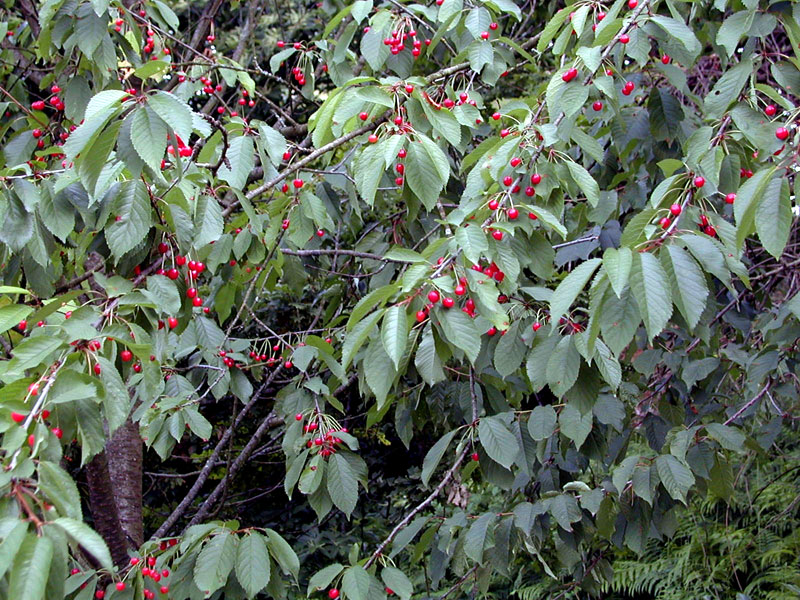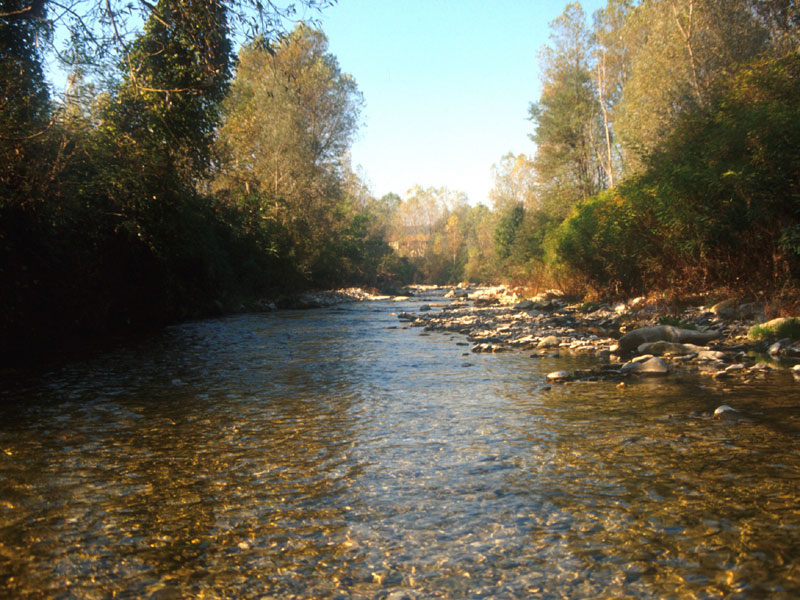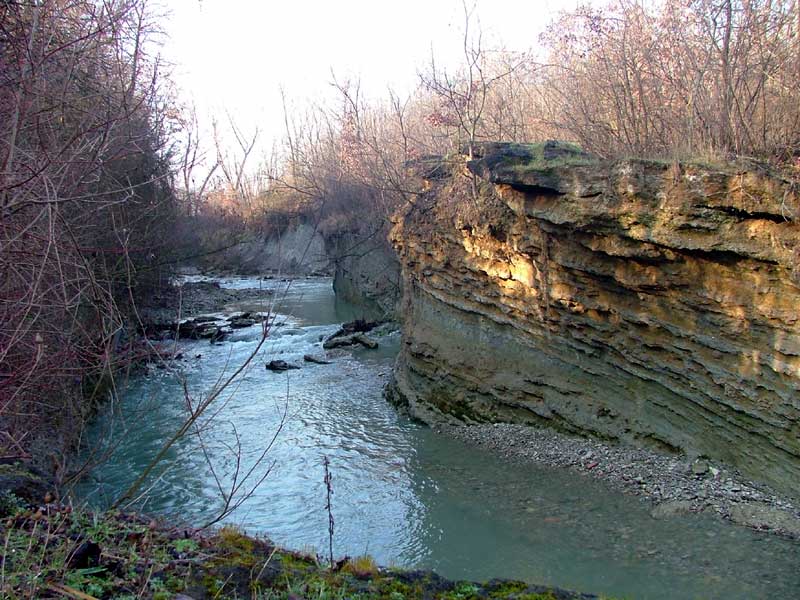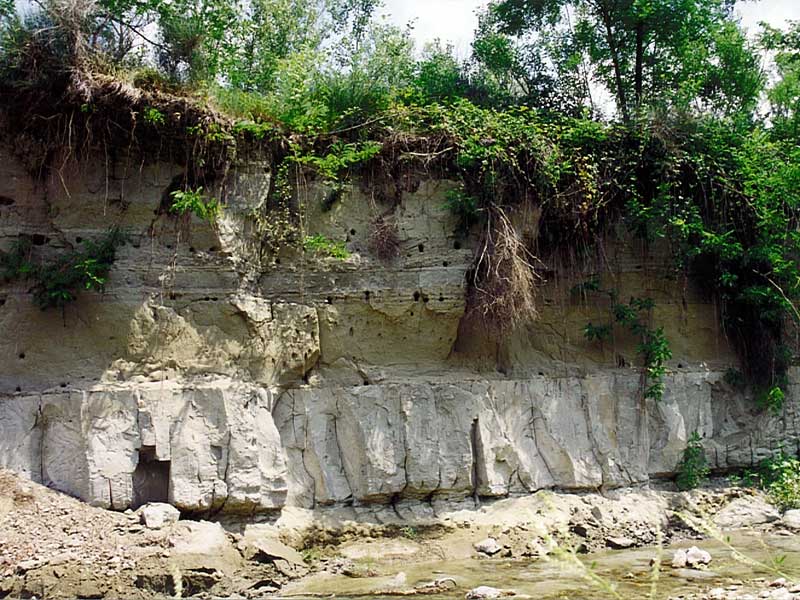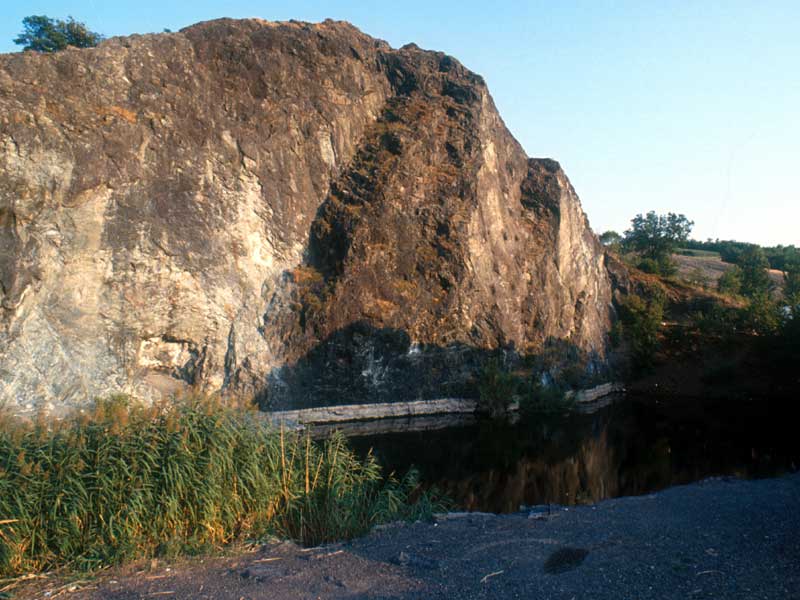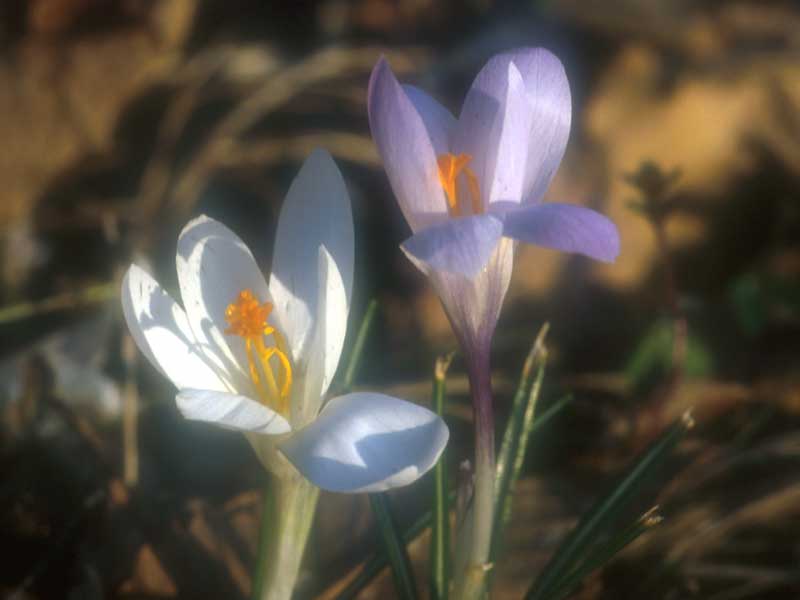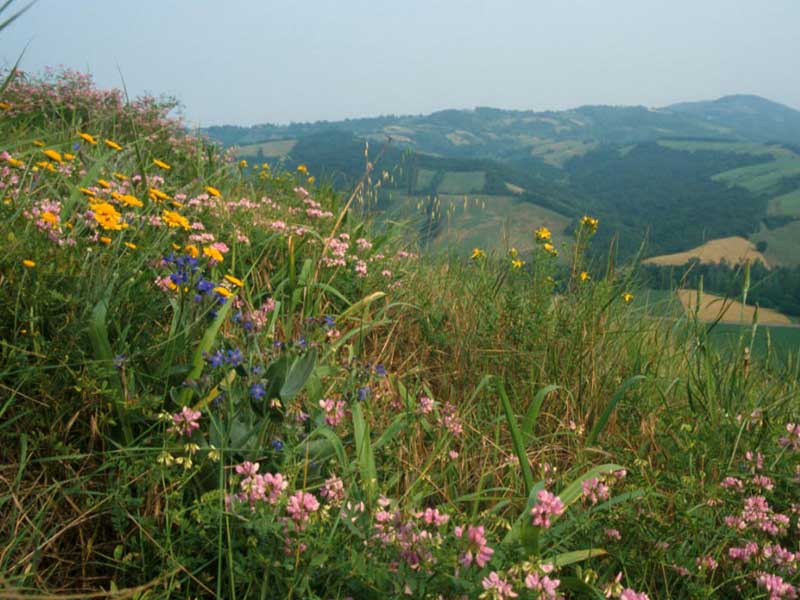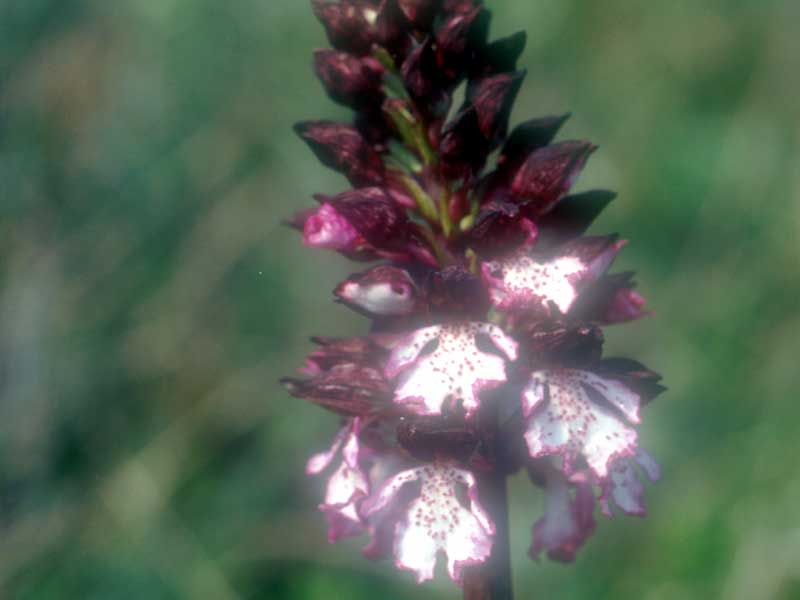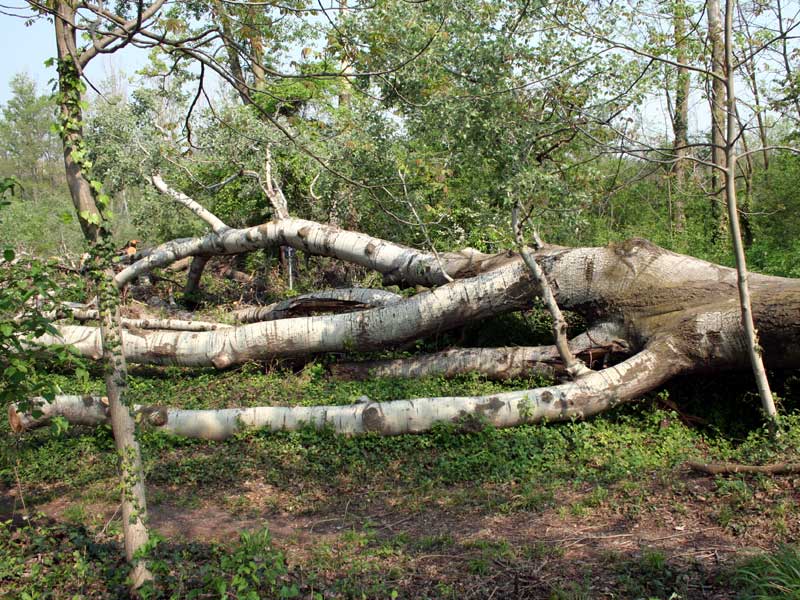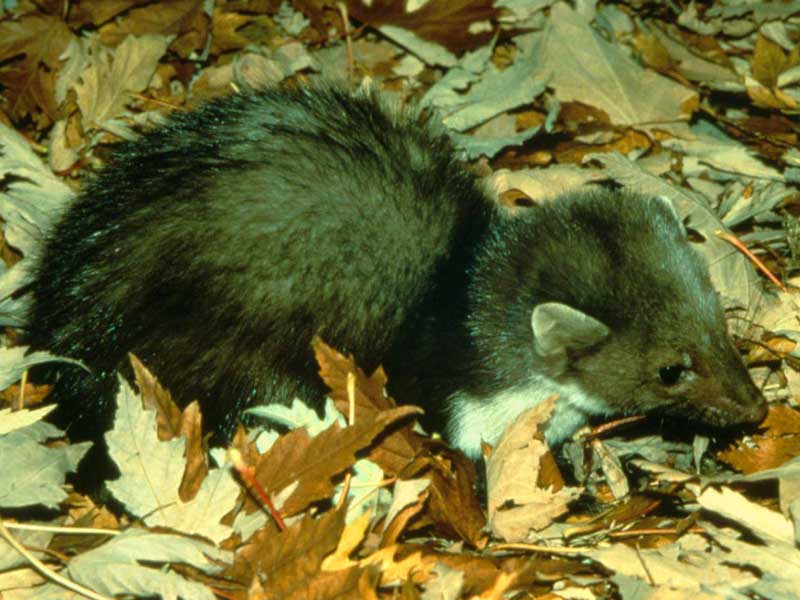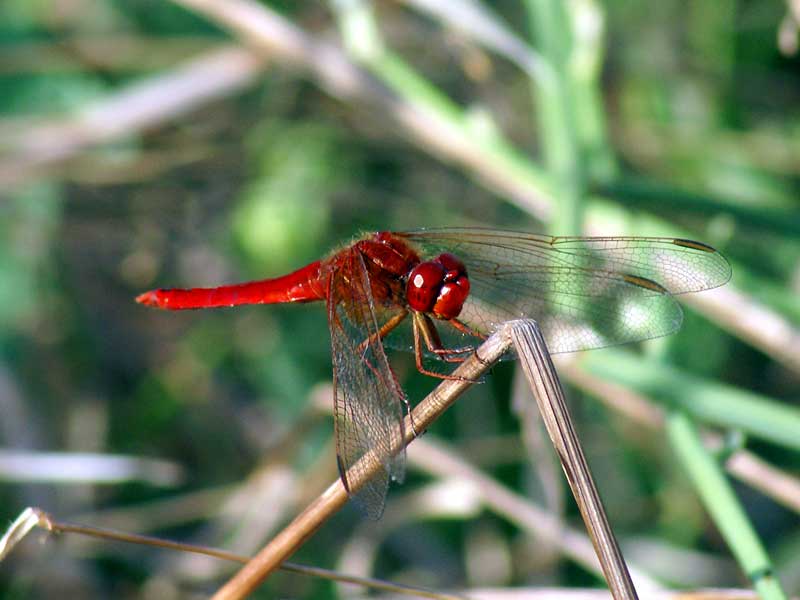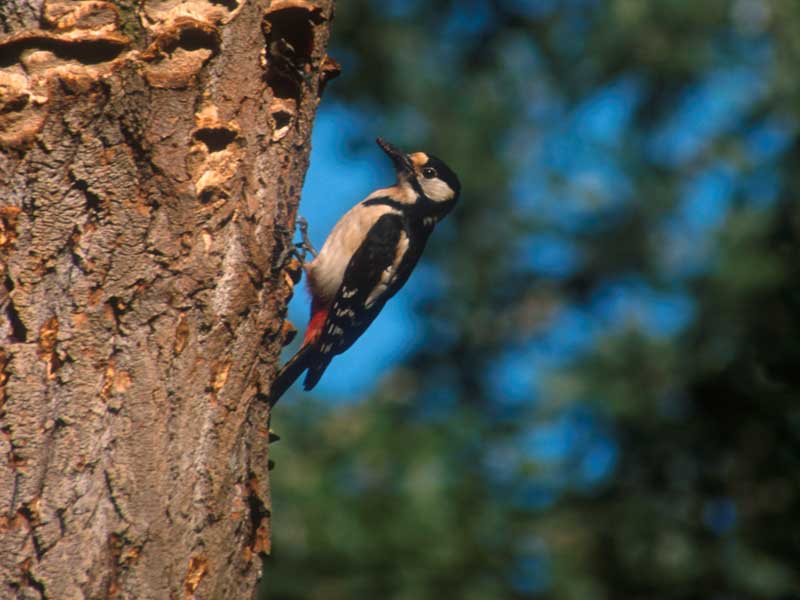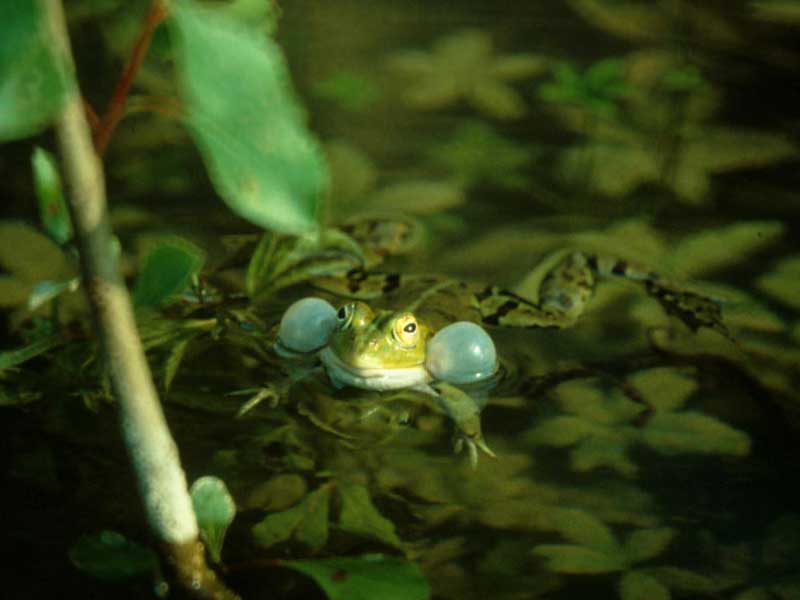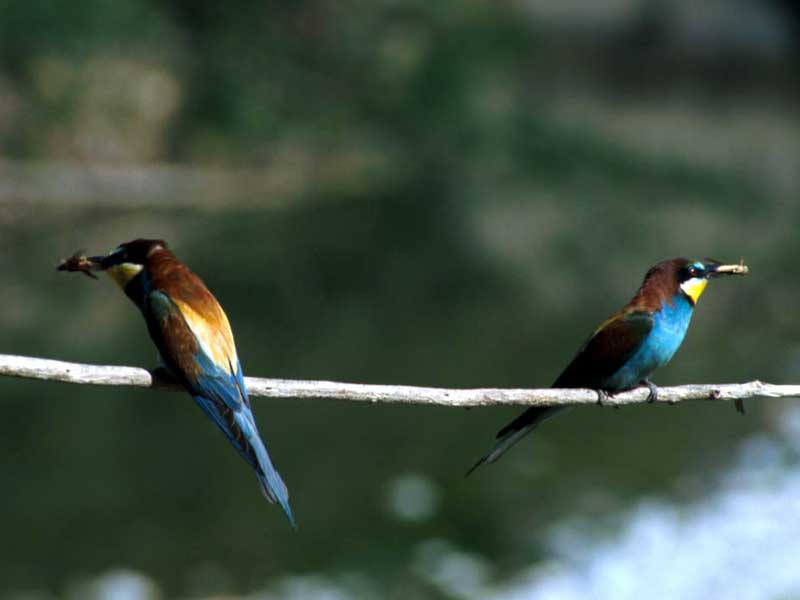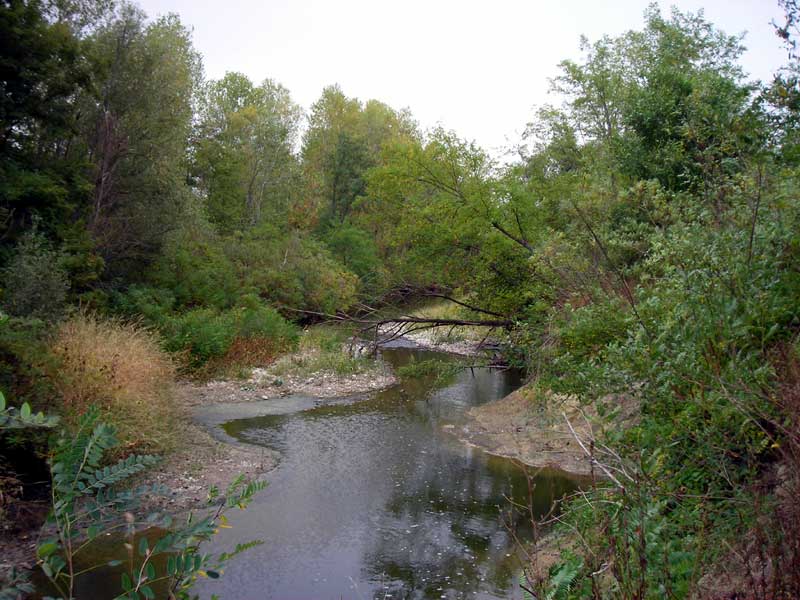Parco Regionale dello Stirone e del Piacenziano
www.parchidelducato.itProtected Area
Identity Card
- Land Surface Area: 2'190.27 ha
- Buffer zone: 525.54 ha
- Protected flora: 4 species (Italian text)
- Protected wildlife: 93 species (Italian text)
- Habitats: 13 types (Italian text)
- Regions: Emilia Romagna
- Provinces: Parma, Piacenza
- Municipalities: Alseno, Carpaneto Piacentino, Castell'Arquato, Fidenza, Gropparello, Lugagnano Val d'Arda, Salsomaggiore Terme, Vernasca
- Establishment Measures: LR 24 23/12/2011
- PA Official List: EUAP0176
Morphological, Paleontological, and Geological Features
River Morphology and Erosion
Torrent Stirone springs from Mt. Santa Cristina, at 963m of altitude in the Municipality of Pellegrino Parmense; it develops for about 55 km, marking almost entirely the border between the Provinces of Parma and Piacenza, and is one of the main left affluents of river Taro. It has a limited water basin (about 300 square meters); its regime is characterized by a distribution of the annual flow with two maximum flows in autumn and spring and two minimum flows in summer and winter. The Park hydrogeological features are deeply linked to its position between the Apennines and the Po Plain, an area characterized by the presence of the gravelly and sandy sediments of the alluvial cone of the stream deposited during the Holocene period (whose beginning dates back to approximately 10,000 years ago). Moreover, the cone is characterized by large terraced areas whose origins are probably linked to the intense erosion carried out by the waters of the torrent within its own deposits.
The current geological and land structure of the watercourse is given to the gravel excavations of the 1950s-60s for the highway Autostrada del Sole. The excavations were too heavy for such a limited size water basin and the gravelly bed was so impoverished that it disappeared; as a consequence, the underlying and less resistant clay was easily subject to the water erosive action. The effects of this erosion appeared in the late 1950s in the area of Laurano, and then continued upstream according to a "regressive" erosion process. The action of the watercourse was so strong that it gave to the stream the aspect of a small canyon in the stretch running between loc. San Nicomede and Laurano.
A sign of a serious instability and degradation, these negative processes have also led to an unexpected and positive environmental event: the outcrop of Stirone marine stratigraphic sequence.
The Evolution through the Fossils
Torrent Stirone is known to paleontology researchers and is object of international scientific studies for the presence of marine sediments particularly rich in fossiliferous finds dating back to the Upper Miocene, the Pliocene, and the Pleistocene (the most ancient finds probably date back to 8 million years ago, while the most recent ones to about 10,000 years ago).
The fossiliferous series starts at loc. La Bocca and ends downstream loc. Laurano; the northern inclination of the strata and their orderly series give the opportunity to trace back, walking from upstream to downstream, the paleoenvironmental and paleoclimatic evolution characterizing the history of the Po Plain Basin in the last 6.5 million years of history of our Planet.
In the past, the area was often called "Outdoor Museum" since, in a few kilometers, it gives the possibility to trace back the history of Earth from approximately 8 million years ago to approximately 1 million years ago.
Loc. Le Cascatelle (named after the presence, until the 1970s, of small waterfalls that have been eroded by the action of the waters) deserves a particular mention: as a matter of fact, the area bears evidences of the important geological limit marking the passage between the Tertiary period and the Quaternary era (dating back to 1.8 million years). This event probably coincided with a general climatic deterioration and with the appearance of wildlife species linked to cold climates, including Arctica islandica, a bivalve mollusk with a gray and thick shell, still living in the North Atlantic Ocean and present in the fossiliferous series of Stirone.
The Gullies in loc. Trabucchi
On the left bank of torrent Stirone, between loc. Trabucchi and San Genesio, it is possible to observe the gullies: they are a characteristic morphology of the clayey formations, consisting of deep-sea sediments deposited on the seabed of the ancient Tethys Ocean (a big sea basin separating during the Secondary Era the area between the two big continents of Eurasia and Africa) in an area next to the current Ligurian Sea.
The gullies look like a complex tangle of furrows divided by steep and often bare slopes subject to an accelerated erosion caused by the meteoric agents. Their morphology is determined by two main factors: the clayey nature of the substratum and the action of meteoric water on this kind of soil.
Besides the geological formation and the surface morphology, another feature of the gullies is represented by vegetation which, for the great aridity of soil, is mainly represented by herbaceous and shrubby species like the Globe Daisy, the Broom, the Dog Rose, the Common Dogwood, the Blackthorn, the Juniper, the Privet, the Downy Oak, as well as several species of ochids and graminaceae. These plants also play an important role of mitigation of the erosion phenomenon, effectively protecting the clay from the surface runoff. The gullies are also a particularly ideal place to carry out interesting wildlife observation activities: diurnal birds of prey (Buzzard, Kestrel, Hen Harrier) and nocturnal birds of prey (Tawny Owl and Barn Owl), other several birds (Common Whitethroat, Subalpine Warbler, Blackcap, Cirl Bunting, Ortolan Bunting), reptiles (lizards and snakes, like the Whip Snake and the Viper), more or less common mammals (Hare, Beech Marten, Least Weasel, Fox, Mole, Hedgehog, Wood Mouse, Common Vole, and Hazel Dormouse) and also amphibians (Common Toad, Edible Frog, Tree Frog, Crested Newt) living in the torrents and pools scattered throughout the clayey slopes.
'Pietra Nera' Ophiolite
Situated at the southern edges of the Park, on the right bank of torrent Stirone and in front of Vigoleno village, "Pietra Nera" (meaning "black stone") is a dark rocky spur standing out in the large Stirone valley for its isolated position, its bare and apparently desolate aspect, and its steep walls. It is an ophiolite, evidence of the most ancient geological events leading to the formation of the Apennines; as a matter of fact, it represents the rests of the rocky material that in the Jurassic period (period of the Secondary Era, between 195 and 135 million years ago) used to form the seabed of the ancient Tethys Ocean. It is an extreme environment housing a specialized flora that lives on particular substrata thanks to specific adaptation techniques: they are plants growing on rocky and dry environments which, to favor the absorption of water and nourishing substances, have a limited size, limited aerial organs sticking to the substratum, long and strong roots; moreover, to cope with the drying problem, they store liquid in their tissues and, to better reflect the light and reduce transpiration, develop linear leaves covered in hair, and often with substances having a hydrophobic function.
Lichens are also worth a mention: they are the real colonizers of hostile substrata, playing the very important role of rock disgregation and preparation of the soil for the settlement of other vegetable organisms.
Flora and Vegetation Features
Along the watercourse
The environments linked to the watercourse are characterized by the presence of vegetation particularly demanding in humidity, sometimes also able to resist although completely submerged. As you leave from the stream, you can observe the more frequent presence of species adapting to dry environments, which have adopted specific strategies to survive to seasonal periods characterized by lack of water.
Since the Park develops along Stirone watercourse, it is possible to observe these different vegetable formations moving from the banks to the hills of the protected area.
Among the arboreal species forming the riparian woodlands from the stream banks to the first cultivated fields, the White Poplar is worth a mention. Thanks to its white-gray bark, it can be recognized in the distance, and in the Park there are several big-size specimens, one of which, imposing and isolated, lies near Fidenza recreational area. However, the most famous White Poplars of the protected area were without a doubt the trees near Scipione Ponte, in loc. La Ronsona: they were trees of extraordinary landscape value, registered and safeguarded by Regione Emilia-Romagna as "monumental trees". Out of "Three Poplars", as they were usually called, only one of them still survives: the others have recently died because of the fungus Perenniporia fraxinea. The Park has decided to leave them on the spot where they continue, according to the natural cycle, their role of creating organic substance for the ecosystem. The "Three Poplars" dominated a much younger riparian woodland, since they had survived the cuttings carried out before the establishment of Stirone Park. Their roots reached a distance of 80 meters on cultivated land.
Near these trees, the Park Consortium carried out in 1996 a natural engineering measure in order to recover a stretch of bank characterized by the presence of an old inert material disposal site.
Further information (Italian text)
The Hills
The hills are characterized by a rather continuous vegetation covering still consisting of oak woodlands dominated by Downy Oaks and, on clayey soils, by Turkey Oaks. The oaks differ one from the other for various specific features, although it is not rare to find cases of specimens having intermediate features, probably given to more or less recent crossbreeds. The lobed leaves, for instance, are often considered one of the distinctive features, but it is not always true: sometimes it is possible to observe variations even on the same specimen.
Among the tree species present in the Park, the Turkey Oak has rather outstretched leaves, with not very marked lobes and seeds (acorns) with a crown covered with long scales; the English Oak has leaves with a short petiole and acorns supported by long peduncles; the Sessile Oak has leaves with not very deep lobes and acorns supported by very short peduncles; the Downy Oak is always characterized by the presence of thick hair on its branches and the bottom side of the leaves, velvety if you touch it.
The oaks of the hilly woodlands grow together with Hop Hornbeam, Flowering Ash, and several species of shrubs, including the Cornel, the Broom, the Common Smoketree, the Dog Rose, and the Juniper. The several species forming the woodland and shrub lower stratum - like several species of anemones, the Snowdrop, the Primrose, the Livewort, the Lungwort, the Dog's tooth violet, the Scilla, the Peony, and the wonderful Burning-bush are safeguarded all over the territory of Regione Emilia-Romagna for their great aesthetic and conservation value, independently from the presence of protected areas. Also the Orchids are subject to a special protection regime: they represent one of the best known flower groups, and the Park gives shelter to several orchid species, some more showy for size and aspect, others less showy but not less important.
The chestnut grove can only be found on Mt. Santo Stefano and in a few areas in the hills; the old surviving chestnut trees - in the past belonging to fruit cultivated areas that have been abandoned by now - represent a very important habitat for small mammals, birds, and invertebrates finding shelter in the several cavities of the trunks and in stumps.
Wildlife Features
Stirone Park is characterized by a rather rich and diversified wildlife: the torrent creates several micro-environments of great interest for the animals that find here food, shelter, and ideal reproduction sites; this contributes to enhance biodiversity, that is the richness of life in the Park. At the moment, the registered species of vertebrates are 239.
The Wetlands
The waters of the torrent house an interesting fish fauna including the Chub, the Vairone, the Common Barbel, the Spined Loach, the South European Nase, and the Padanian goby, the latter an exclusive species of the Po Plain. The riverbed, its banks, and the artificial lakes house many birds, like Gray Herons, Little Egrets, Night Herons, Mallards, Coots, Moorhens, and Little Grebes. The banks interested by erosion offer the Kingfisher reproduction sites and excellent observation points to sight and catch its preys. In spring, the current waters and the pools forming on the side of the watercourse house several species of amphibians (Common Toad, Edible Frog, Agile Frog, Crested Newt, Smooth Newt, and Alpine Newt) and invertebrates (like for instance dragonflies and butterflies). The river banks also represent the ideal environment for two reptiles: the Grass Snake and the Viperine Snake.
The Woodlands
The forest formations, running along the torrent in its course to the plain, represent one of the environments richest in wildlife. Here predators like the Sparrow Hawk, the Eurasian Hobby, the Eurasian Scops Owl, the Long-eared Owl, the Beech Marten and the Least Weasel live, together with species with a varied diet, like the Badger, and rodents like the Squirrel, the Porcupine, the Dormouse, the Hazel Dormouse, and the Wood Mouse.
The birds include the Green Woodpecker, the Great-spotted Woodpecker, the Lesser-spotted Woodpecker, and several passerines, like the Golden Oriole, the Nightingale, the Blackcap, the Robin, and the Chiffchaff. The oak woodlands of the plain welcome the Buzzard, the Eurasian Jay, the Great Tit and the Blue Tit, as well as little mammals, like the Common Shrew. The oak woodlands of the hills are the hunting sites of the Aesculapian Snake, the Hopooe, and the Nightjar. The Fox can be found almost everywhere, from the banks to the cultivated fields and the woodlands, where it is also possible to meet the Wild Boar. The chestnut grove, not very widespread in the Park, houses the Tawny Owl and the Eurasian Nuthatch.
The Cultivated Areas
The agri-ecosystems, very simplified with respect to the natural environments, are populated by species using the cultivations and the remaining natural spaces, like the Hedgehog, the Mole, the Hare, the Pheasant, the Quail, the Turtle Dove, the Goldfinch, the Skylark, the Yellow Wagtail, the African Stonechat, and the Corn Bunting. Where the fields are surrounded by hedges and tree rows, it is possible to find the Common Cuckoo, the Little Owl, the Hooded Crow, and the Magpie. The fields are also hunting sites for rare species only occasionally visiting the Park, like the Stork and the Black Stork.
The Uncultivated Areas
Some reptiles live in the areas mainly covered with herbaceous vegetation: the Common Wall Lizard, the Italian Wall Lizard, the European Green Lizard, and the Viper, the one and only poisonous species in the Park. The winged predator often hovering over the open fields is the Kestrel, a small and rather common hawk.
The Settlements
The small rural settlements of the Park house common species like the House Sparrow, the Eurasian Tree Sparrow, the Common Swift, the Swallow, the Common House Martin, the Blackbird, the Collared Dove, but also less known bird species, including the Common Redstart and the Spotted Flycatcher. In the attics and the barns it is not rare to find the Barn Owl, night hunter like the Common Pipistrelle. Vigoleno Castle houses, besides several pigeons, a colony of Jackdaws, small Corvids with a characteristic call.
The Bee Eater
Nesting in the Park since 1984, it is nowadays one of the most important species in the protected area. This bird is mainly known for its aspect: as a matter of fact, it can't go unnoticed for the wonderful colors of its plumage, from bright green-blue to golden yellow, making it one of the most showy specimens among European birds. Moreover, its reproduction habits enhance its role as the symbol of Stirone Park: the Bee Eater reproduces in colonies along the stream, along the vertical banks shaped by the erosive action, exactly near the sites of paleontological interest. A migratory and summer bird, widespread as a nesting bird - although in a localized manner almost throughout the peninsula - in Sicily and Sardinia, the Bee Eater has extended its distribution area to the Po Plain since the mid-80s. It builds its nests by digging long horizontal or slightly inclined galleries in sandy and clayey soils with one or more entrance holes.
The Park offers this bird a wide range of preys (dragonflies, wasps, bees, and butterflies), to the extent that the species has recently increased in number, reaching the 150 couples divided into different reproduction nuclei. These birds can be observed in the Park from the first ten days of May, even if sometimes some of them already reach the Park in late April.
Further information (Italian text)
The Park Environments
The Watercourse
For the Park Authority of a river park, the safeguard of the environments linked to the watercourse is one of the main aims and at the same time one of the most demanding tasks. In the Park, zone A (strict protection area) and zone B (general protection area) correspond with the bed of torrent Stirone and the immediately surrounding territory including the periodically flooded banks, the bank walls subject to erosion, and the riparian woodland. They are areas interested by the presence of particularly fragile ecosystems: as a matter of fact, each watercourse is an open environment subject to outer impacts that can irreparably damage plants and animals.
Torrent Stirone springs from Mt. Santa Cristina, at 963m of altitude in the Municipality of Pellegrino Parmense; it develops for about 55 km, marking almost entirely the border between the Provinces of Parma and Piacenza, and is one of the main left affluents of river Taro. Along the 15 km of the torrent within the Park territory, from La Villa to Fidenza, the watercourse creates very different environments according to the season: the spring and autumn floods, short but intense, shape the landscape and the bank morphology, while the summer low waters almost completely dry up the bed. In these difficult moments, the survival of many organisms is represented by the small pools forming at the edges of the torrent: as a matter of fact, they are essential for the survival of fish and invertebrates, and their respective predators, like herons and insectivorous birds. Moreover, the watercourse houses many interesting invertebrates that are important to analyze the quality of the waters, since they are particularly sensitive to pollution. The European freshwater crayfish belongs to these indicators of good environmental quality: although it had almost disappeared, today it is possible to find it in the Park, and it demonstrate the recent improvement of the water conditions.
The Riparian Woodland
It is the most widespread forest formation along the banks of the watercourses, characterizing the most raised terraces covered with water only during the floods. The area closest to the torrent is dominated by hygrophilous shrubs, that is plants growing in a wet environment, and is dominated by willow trees, whose pliable branches can resist the impetuosity of floods and short periods underwater. Farther away from the water, there is an area covered by real woodland, with still hygrophilous arboreal species (White Willow, White Poplar, Black Poplar, Black Alder). In some cases, there are also species characteristic of the plain woodlands covering the Po Plain in the past: English Oak, Common Hornbeam, Field Maple, Field Elm. The undergrowth is also particularly rich in species. Among the most common, it is possible to recognize the Hawthorn, the Alder Buckthorn, the European Cornel, the Lantana, the Hazelnut tree. An environment with such a varied and well-structured vegetation houses a wildlife very rich in species, where all the most important animal groups are represented, from the most simple to the most complex organisms (insects, spiders, mollusks, amphibians, birds, mammals). The riparian woodlands can be found along most of the course of the torrent, except in the stretches where the agricultural activities have entirely eliminated the trees.
The Oak Woodland
The broadleaf tree woodlands are situated in the hills of the Park, since the oak woodlands characterizing the plain disappeared a long time ago to give way to agriculture and human settlements. The most widespread arboreal species is without a doubt the Downy Oak, growing together with many shrub and herbaceous species.
Some History
The presence of man in the Park territory and the adjacent areas dates back to the Lower Paleolithic Age (150,000 BC): objects have been found near the old river beds, used by the local population to create tools and instruments. The first settlements formed in the piedmont area, between the middle plain and the first river terraces, an area characterized by a greater stability than the plain interested by evolution processes. These populations mainly lived on hunting, fishing, and collection of spontaneous fruits, while cattle breeding was not fully developed yet.
Further information (Italian text)
(Texts by Sergio Tralongo and Monica Dominici)


